ARS: Adaptive Robust Synchronization for Underground Coal Wireless Internet of Things
Abstract
1. Introduction
- To the best of our knowledge, we are the first to investigate the adaptive clock synchronization for wireless IoT in underground mines, which resolves the packet loss and possible outliers based on Kalman filtering.
- The synchronization scheme is proposed for both single-hop and multi-hop networks. Moreover, the upper and lower bounds of error covariance expectation are analyzed in the case of incomplete measurement.
- We provide multiple simulation experiments to verify the above theoretical results. Because multi-hop clock synchronization is common in real life, we can extend the proposed synchronization strategy to multi-hop network scenarios.
2. Related Work
3. Kalman Filter Based Clock Model
3.1. Classical Clock Model
3.1.1. Continuous-Time Clock Model
3.1.2. Discrete-Time Clock Model
3.2. Practical Universal Clock Model
3.3. Observation Model Establishment
3.4. Kalman Filtering Model of Clock
4. Adaptive Robust Synchronization Algorithm
4.1. Single-Hop Networks Scenario
4.2. Multi-Hop Networks Scenario
5. Simulations
5.1. First-Order Kalman Filtering for Single-Hop Networks
5.2. Second-Order Kalman Filtering for Single-Hop Networks
5.3. First-Order Kalman Filtering for Multi-Hop Networks
6. Conclusions
Author Contributions
Funding
Conflicts of Interest
References
- Liu, C.; Pang, H.; Cao, N. Research on Time Synchronization Technology of Wireless Sensor Network. In Proceedings of the 2017 International Conference on Cyber-Enabled Distributed Computing and Knowledge Discovery (CyberC), Nanjing, China, 12–14 October 2017; pp. 391–394. [Google Scholar]
- Giorgi, G.; Narduzzi, C. Performance Analysis of Kalman-Filter-Based Clock Synchronization in IEEE 1588 Networks. IEEE Trans. Instrum. Meas. 2011, 60, 2902–2909. [Google Scholar] [CrossRef]
- Yıldırım, K.S.; Carli, R.; Schenato, L. Adaptive Proportional—Integral Clock Synchronization in Wireless Sensor Networks. IEEE Trans. Control Syst. Technol. 2017, 26, 610–623. [Google Scholar] [CrossRef]
- Lin, L.; Ma, S.; Ma, M. A Group Neighborhood Average Clock Synchronization Protocol for Wireless Sensor Networks. Sensors 2014, 14, 14744–14764. [Google Scholar] [CrossRef] [PubMed]
- Nilsson, J.; Händel, P. Robust recursive network clock synchronization. In Proceedings of the 2014 IEEE International Conference on Electronics, Computing and Communication Technologies (CONECCT), Bangalore, India, 6–7 January 2014; pp. 1–5. [Google Scholar]
- Jin, M.; Fang, D.; Chen, X.; Yang, Z.; Liu, C.; Yin, X. Voltage-Aware Time Synchronization for Wireless Sensor Networks. Int. J. Distrib. Sens. Netw. 2015, 10, 285265. [Google Scholar] [CrossRef]
- Yildirim, K.S.; Carli, R.; Schenato, L. Adaptive control-based clock synchronization in wireless sensor networks. In Proceedings of the 2015 European Control Conference (ECC), Linz, Austria, 15–17 July 2015; pp. 2806–2811. [Google Scholar]
- Elson, J.; Girod, L.; Estrin, D. Fine-grained network time synchronization using reference broad- casts. ACM SIGOPS Oper. Syst. Rev. 2002, 36, 147–163. [Google Scholar] [CrossRef]
- Ganeriwal, S.; Kumar, R.; Srivastava, M.B. Timing-sync protocol for sensor networks. In Proceedings of the 1st International Conference on Embedded Networked Sensor Systems, Los Angeles, CA, USA, 5–7 November 2003; pp. 138–149. [Google Scholar]
- Akhlaq, M.; Sheltami, T.R. RTSP: An Accurate and Energy-Efficient Protocol for Clock Synchronization in WSNs. IEEE Trans. Instrum. Meas. 2013, 62, 578–589. [Google Scholar] [CrossRef]
- Alexandrov, A.; Monov, V. Method for WSN clock synchronization based on optimized SLTP protocol. In Proceedings of the 2017 25th Telecommunication Forum (TELFOR), Belgrade, Serbia, 21 November 2017; pp. 1–4. [Google Scholar]
- Zhong, Z.; Chen, P.; He, T. On-demand time synchronization with predictable accuracy. In Proceedings of the Infocom IEEE International Conference on Computer Communications, Shanghai, China, 10–15 April 2011; pp. 2480–2488. [Google Scholar]
- Wang, T.; Shang, J.; Tang, X. Quantitative Analysis for Networked Output Feedback MPC of Clock Synchronization in Unreliable WSN. IEEE Access. 2019, 7, 56839–56851. [Google Scholar] [CrossRef]
- Giorgi, G.; Narduzzi, C. A resilient Kalman filter based servo clock. In Proceedings of the 2013 IEEE International Symposium on Precision Clock Synchronization for Measurement, Control and Communication (ISPCS) Proceedings, Lemgo, Germany, 22–27 September 2013; pp. 59–64. [Google Scholar]
- Ting, J.; Theodorou, E.; Schaal, S. A Kalman filter for robust outlier detection. In Proceedings of the 2007 IEEE/RSJ International Conference on Intelligent Robots and Systems, San Diego, CA, USA, 29 October–2 November 2007; pp. 1514–1519. [Google Scholar]
- Agamennoni, G.; Nieto, J.I.; Nebot, E.M. An outlier-robust Kalman filter. In Proceedings of the 2011 IEEE International Conference on Robotics and Automation, Shanghai, China, 9–13 May 2011; pp. 1551–1558. [Google Scholar]
- Tavares-Bruscato, L.; Heimfarth, T.; Pignaton de Freitas, E. Enhancing Time Synchronization Support in Wireless Sensor Networks. Sensors 2017, 17, 2956. [Google Scholar] [CrossRef]
- Castillo-Secilla, J.M.; Palomares, J.M.; León, F.; Olivares, J. Homomorphic Filtering for Improving Time Synchronization in Wireless Networks. Sensors 2017, 17, 909. [Google Scholar] [CrossRef]
- Masood, W.; Schmidt, J.F.; Brandner, G. DISTY: Dynamic Stochastic Time Synchronization for Wireless Sensor Networks. IEEE Trans. Ind. Inform. 2017, 13, 1421–1429. [Google Scholar] [CrossRef]
- Zhang, X.; Chen, H.; Lin, K.; Wang, Z.B.; Yu, J.G.; Shi, L.Y. RMTS: A robust clock synchronization scheme for wireless sensor networks. J. Netw. Comput. Appl. 2019, 135, 1–10. [Google Scholar] [CrossRef]
- Qiu, T.; Zhang, Y.; Qiao, D.; Zhang, X.; Wymore, M.L.; Sangaiah, A.K. A Robust Time Synchronization Scheme for Industrial Internet of Things. IEEE Trans. Ind. Inform. 2018, 14, 3570–3580. [Google Scholar] [CrossRef]
- Hamilton, B.R.; Ma, X.; Zhao, Q.; Xu, J. ACES: Adaptive clock estimation and synchronization using Kalman filtering. In Proceedings of the MobiCom ’08: 14th ACM International Conference on Mobile Computing and Networking, San Francisco, CA, USA, 14–19 September 2008; pp. 152–162. [Google Scholar]
- Qiang, L.; Xue, L.; JingLun, Z.; Gang, Z.; Guang, J.; Quan, S.; Min, X. A General Adaptive Clock Synchronization Scheme Based on Kalman Filter for WSNs. Wirel. Pers. Commun. 2012, 63, 217–239. [Google Scholar]
- Seo, Y.-D.; Son, K.J.; An, G.-S.; Nam, K.D.; Chang, T.G.; Kang, S.-H. Improved Time-Synchronization Algorithm Based on Direct Compensation of Disturbance Effects. Sensors 2019, 19, 3499. [Google Scholar] [CrossRef] [PubMed]
- Xu, W.D.; Wang, Z.J.; Ding, E.J. A time synchronization algorithm for underground linear WSN. Ind. Mine Autom. 2013, 39, 51–55. [Google Scholar]
- Zhenping, C.; Yourui, H.; Chaoli, T.; Liguo, Q.U. Estimation of transmission delay of time synchronization information for Internet of things of coal mine underground. Ind. Mine Autom. 2014, 12, 37–41. [Google Scholar]
- Tan, A.; Peng, Y.; Su, X.; Tong, H.; Deng, Q. A Novel Synchronization Scheme Based on a Dynamic Superframe for an Industrial Internet of Things in Underground Mining. Sensors 2019, 19, 504. [Google Scholar] [CrossRef]
- Liao, X.; Huang, Q.; Sun, D.; Liu, W.; Han, W. Real-time road slope estimation based on adaptive extended Kalman filter algorithm with in-vehicle data. In Proceedings of the 2017 29th Chinese Control And Decision Conference (CCDC), Chongqing, China, 28–30 May 2017; pp. 6889–6894. [Google Scholar]
- Giorgi, G. An Event-Based Kalman Filter for Clock Synchronization. IEEE Trans. Instrum. Meas. 2015, 64, 449–457. [Google Scholar] [CrossRef]
- Tatsushi, K.; Takahiro, Y. A precise time synchronization method for real-time schedulers. IEEJ Trans. Electron. Inf. Syst. 2018, 138, 695–702. [Google Scholar]
- Miljkovic, D.; Trump, T.; Petrović, G. Clock Skew Compensation by Speech Interpolation. In Proceedings of the International Conference on Digital Telecommunications (ICDT’06), Cote d’Azur, France, 29–31 August 2006; p. 66. [Google Scholar]
- Yang, W.L.; Fu, M.Y. A Filter-based Clock Synchronization Protocol for Wireless Sensor Networks: Filter-based Clock Synchronization Protocol. Asian J. Control 2019, 21, 1389–1403. [Google Scholar] [CrossRef]
- Li, X.; Xi, M.; Cao, Y. Clock Synchronization Using Expectation-Maximization Algorithm in Wireless Sensor Network. In Proceedings of the 2012 International Conference on Computer Science and Service System, Nanjing, China, 11–13 August 2012; pp. 1166–1169. [Google Scholar]
- Veitch, D.; Babu, S.; Pàsztor, A. Robust synchronization of software clocks across the internet. In Proceedings of the 4th ACM SIGCOMM Conference on Internet Measurement, Taormina, Italy, 25–27 October 2004; pp. 219–232. [Google Scholar]
- Sinopoli, B.; Schenato, L.; Franceschetti, M.; Poolla, K.; Jordan, M.I.; Sastry, S.S. Kalman Filtering with Intermittent Observations. IEEE Trans. Autom. Control. 2004, 49, 1453–1464. [Google Scholar] [CrossRef]
- Akhlaghi, S.; Zhou, N.; Huang, Z. Adaptive adjustment of noise covariance in Kalman filter for dynamic state estimation. In Proceedings of the 2017 IEEE Power &Energy Society General Meeting, Chicago, IL, USA, 16–20 July 2017; pp. 1–5. [Google Scholar]
- Wang, T.; Guo, D.; Cai, C.Y.; Tang, X.M.; Wang, H. Clock Synchronization in Wireless Sensor Networks: Analysis and Design of Error Precision Based on Lossy Networked Control Perspective. Math. Probl. Eng. 2015, 2015, 346521. [Google Scholar]
- Xiao, P.; Strom, E.; Carrasco, R. Estimation of time-varying multipath Rayleigh fading channels in asynchronous DS-CDMA systems. In Proceedings of the 2004 IEEE 15th International Symposium on Personal, Indoor and Mobile Radio Communications, Barcelona, Spain, 5–8 September 2004; pp. 2570–2575. [Google Scholar]
- Zhao, Q.; Zhao, H.; Zhu, B. Research on time synchronization algorithm of TTE multi-hop system based on IEEE1588 protocol. In Proceedings of the 2017 3rd IEEE International Conference on Computer and Communications (ICCC), Chengdu, China, 13–16 December 2017; pp. 229–234. [Google Scholar]
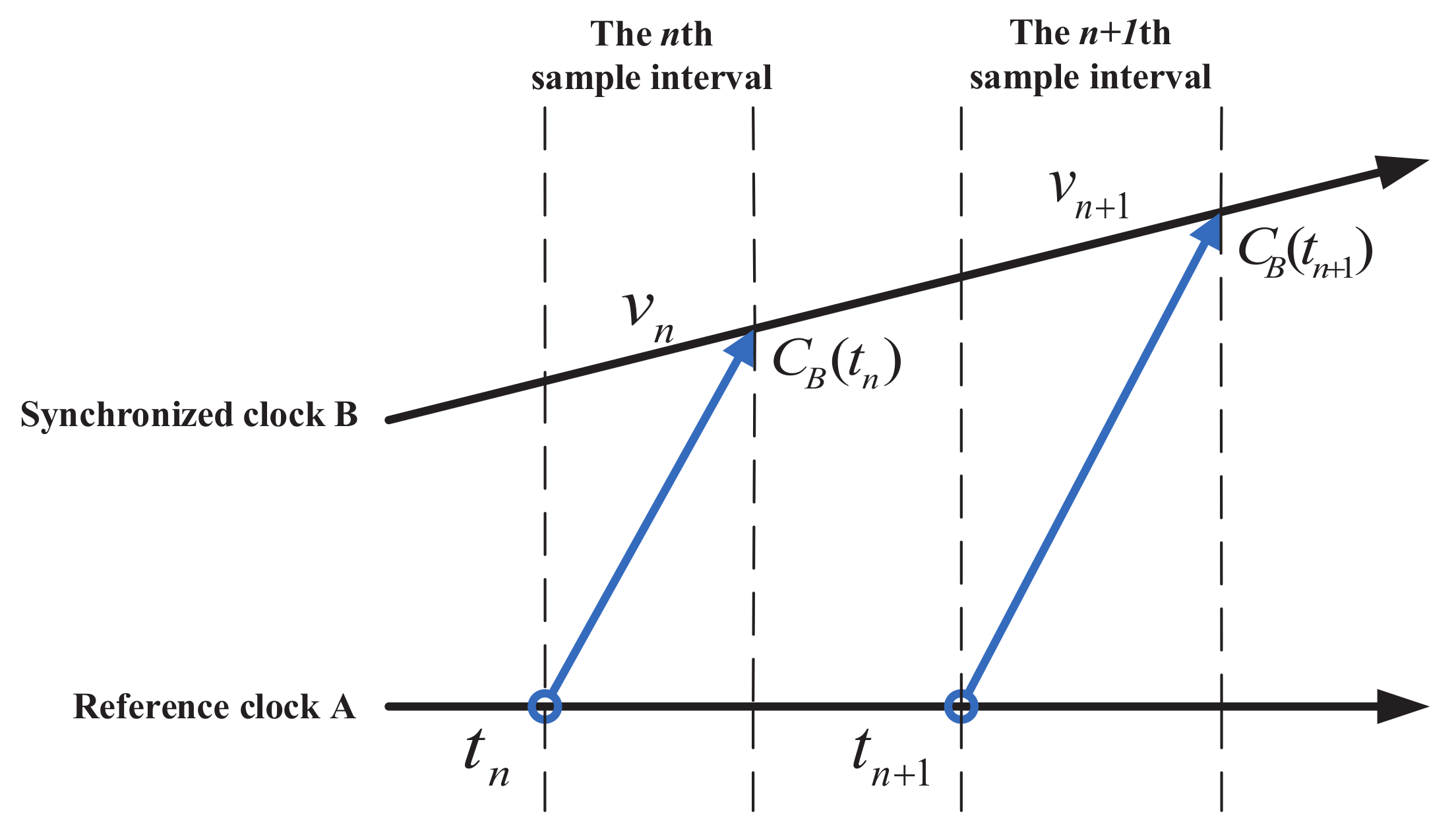

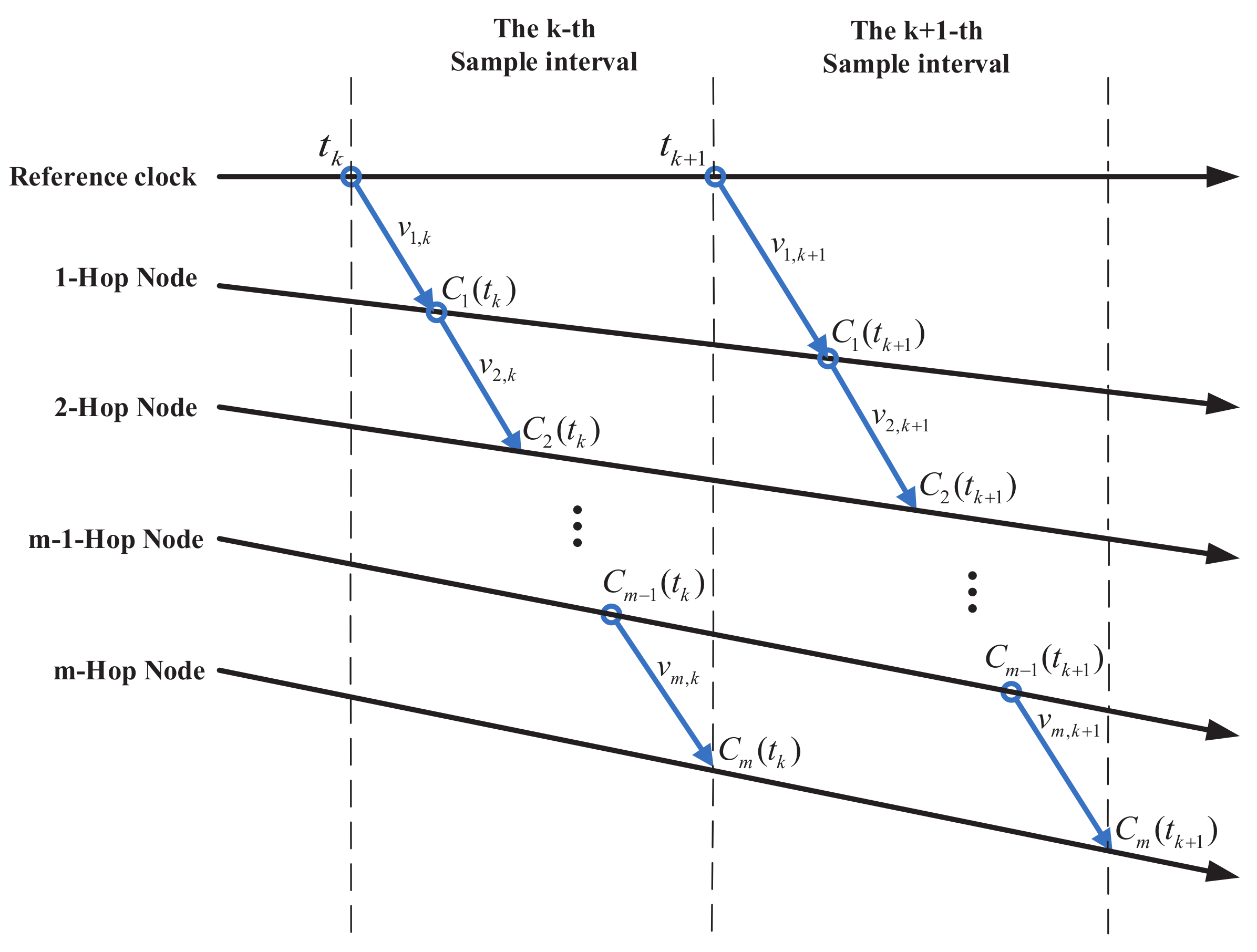
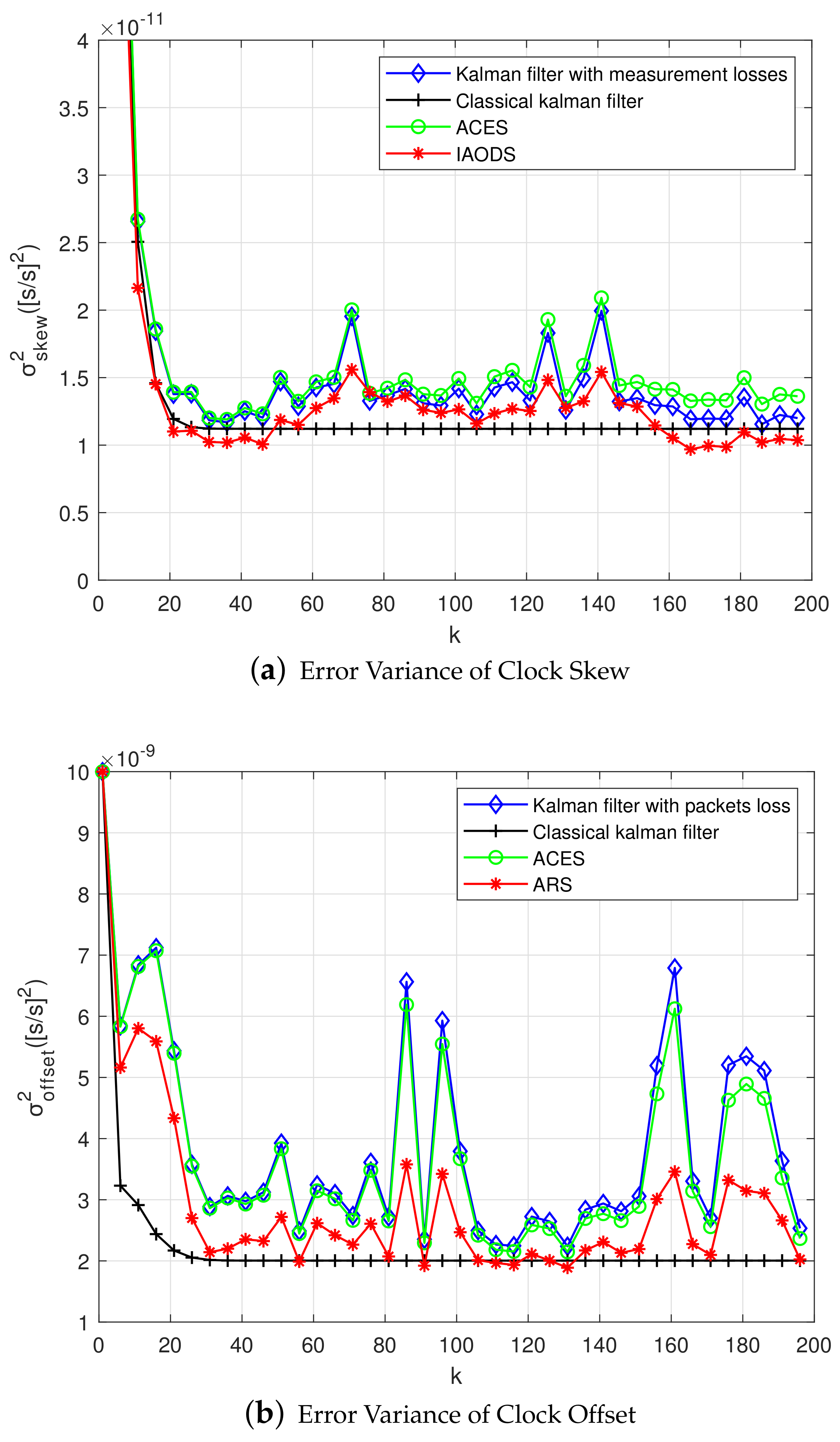
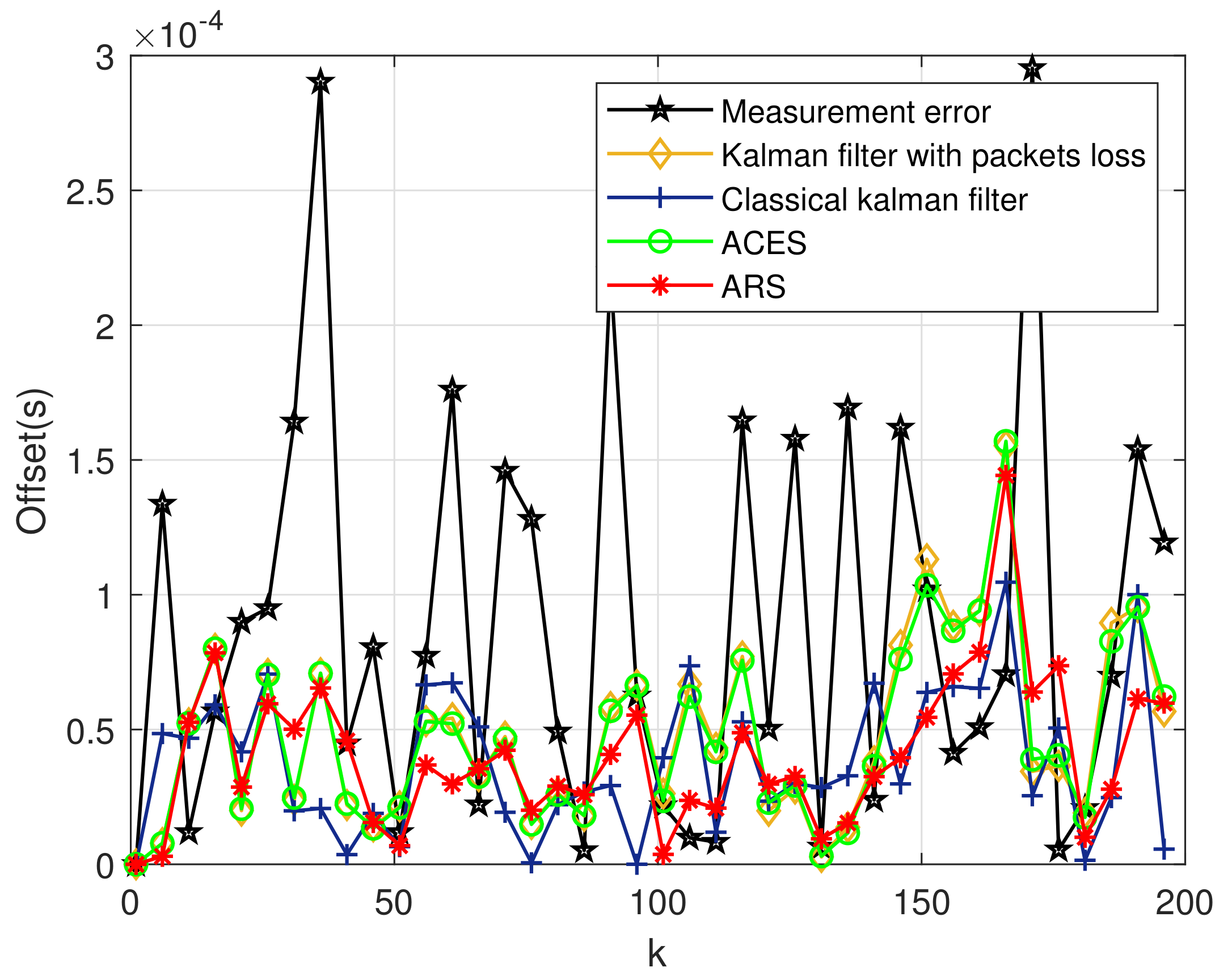
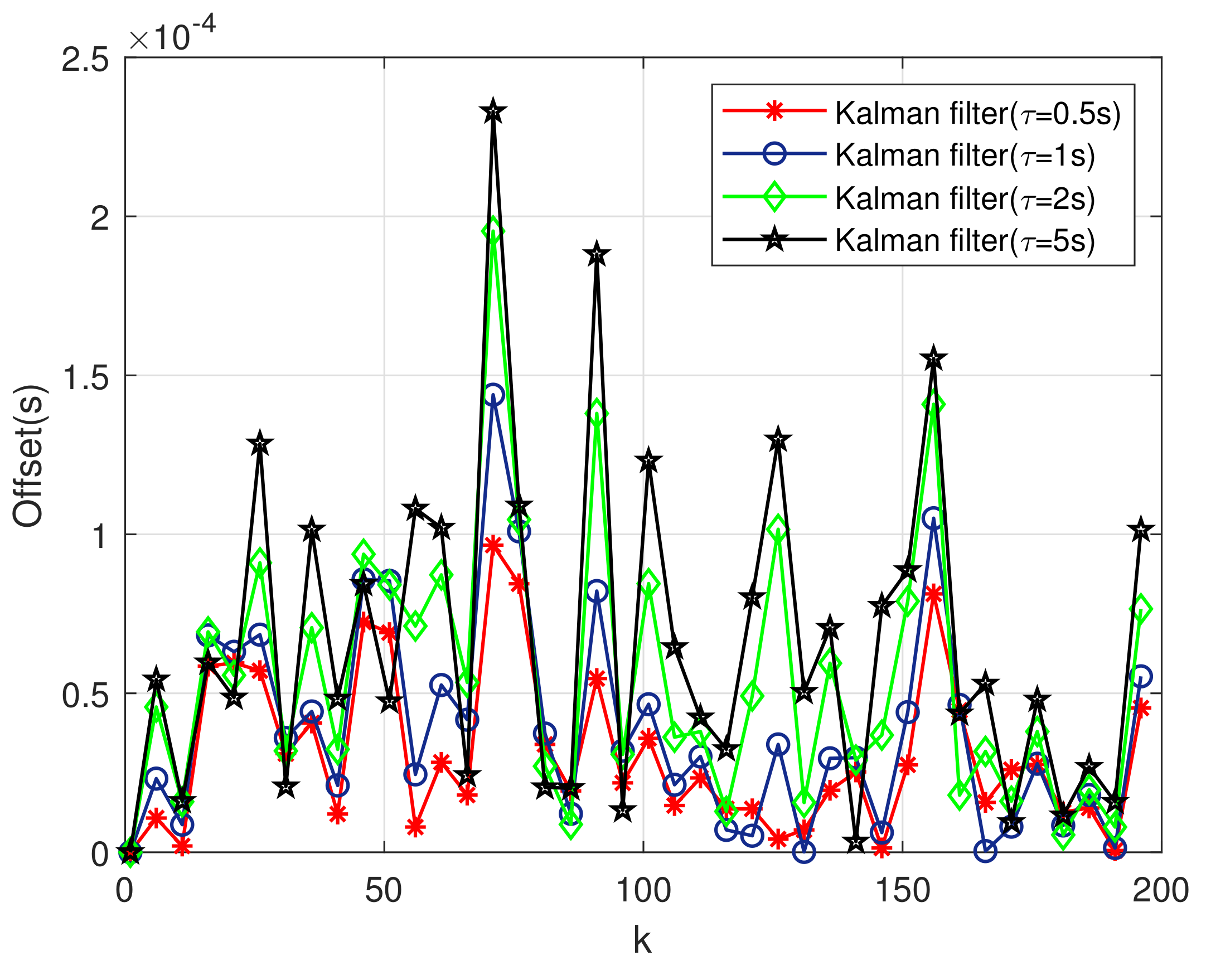
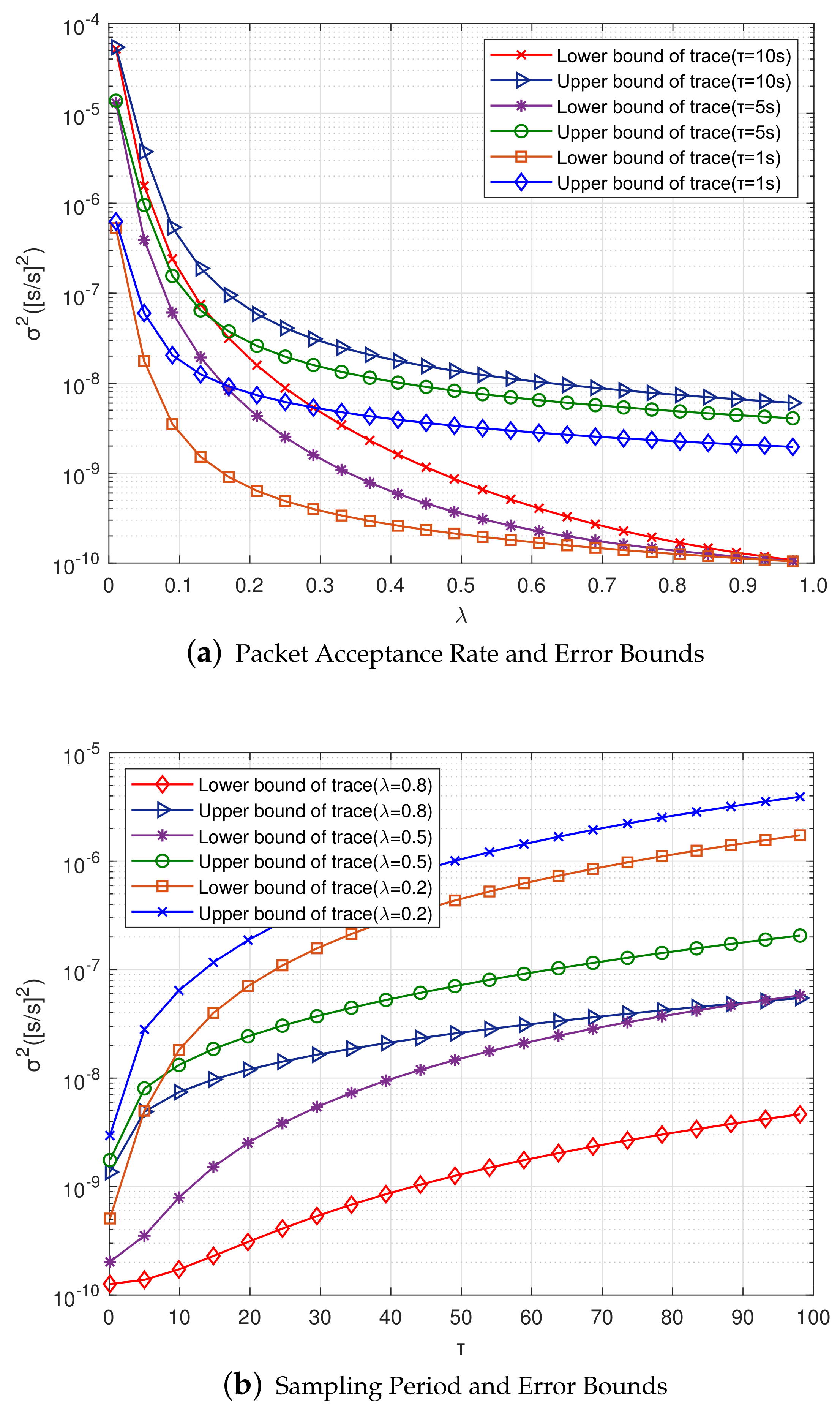
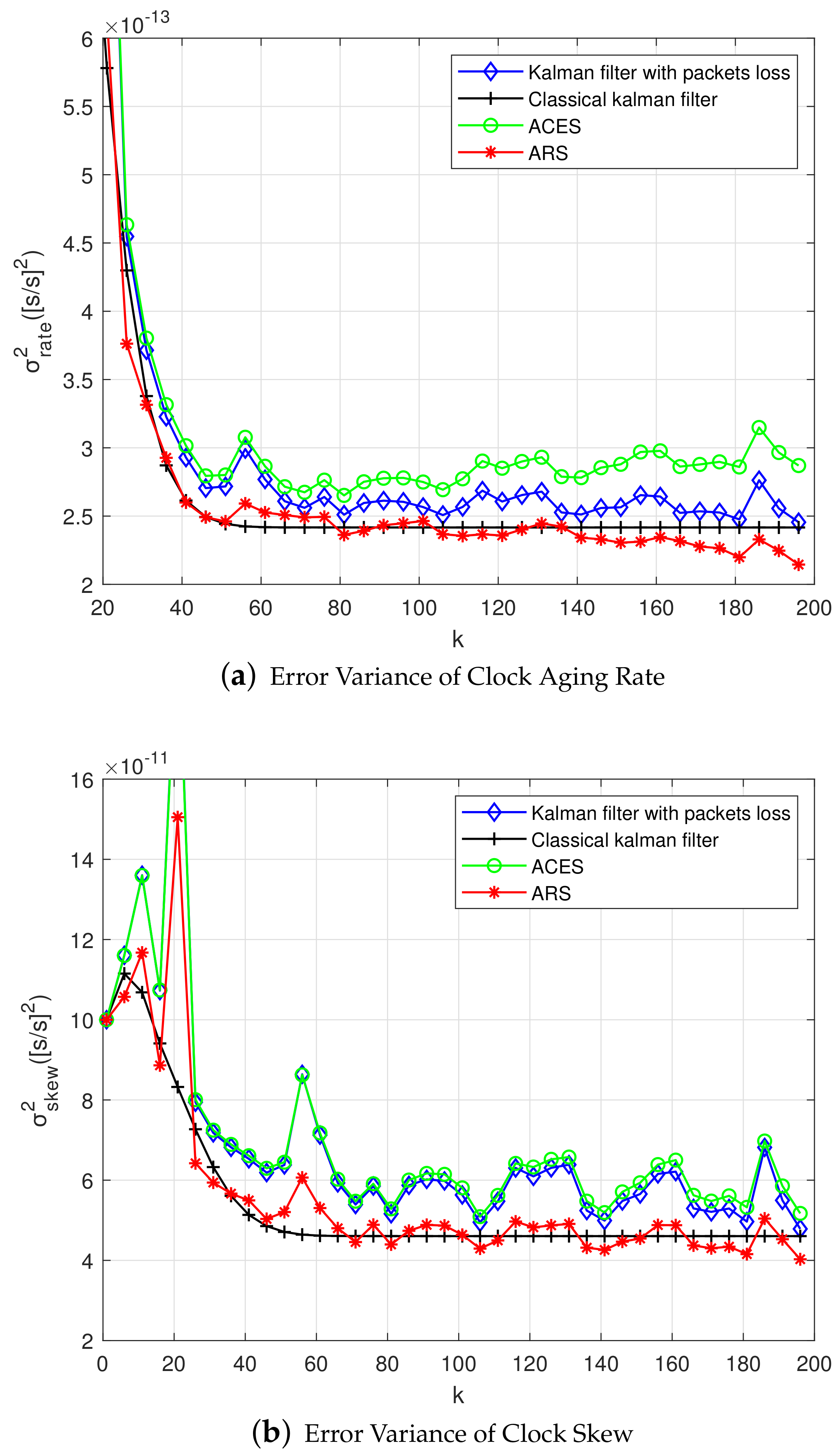
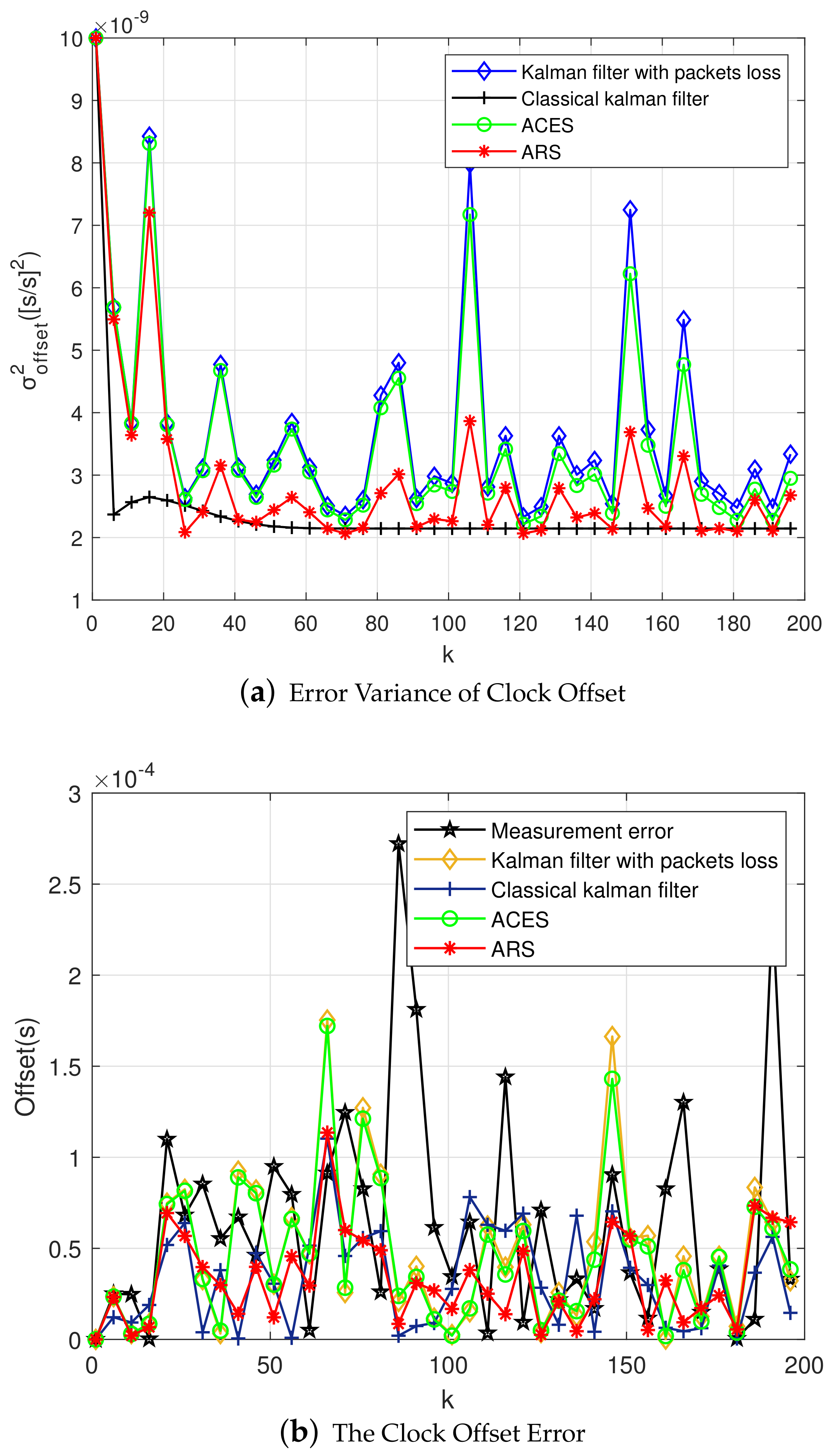
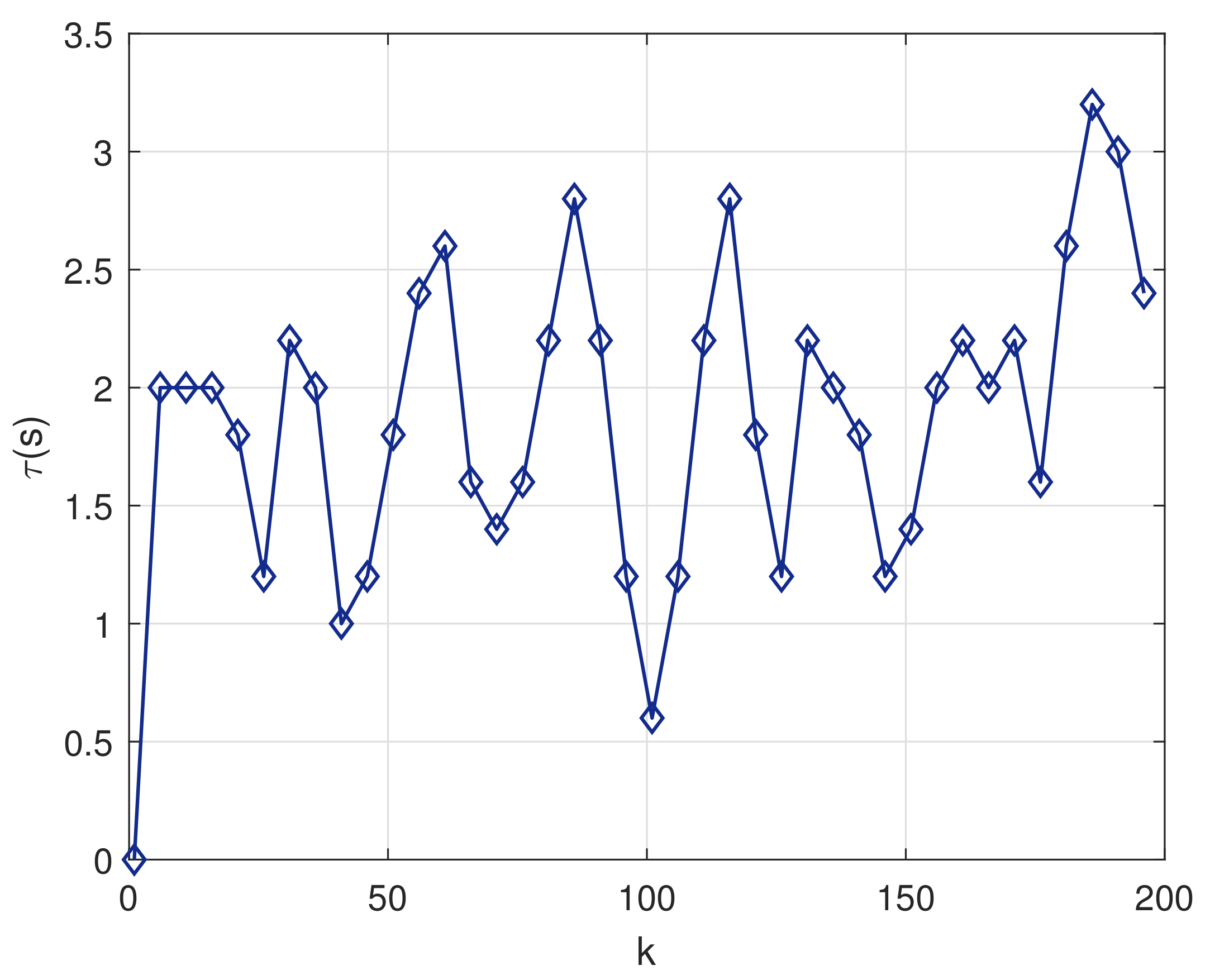
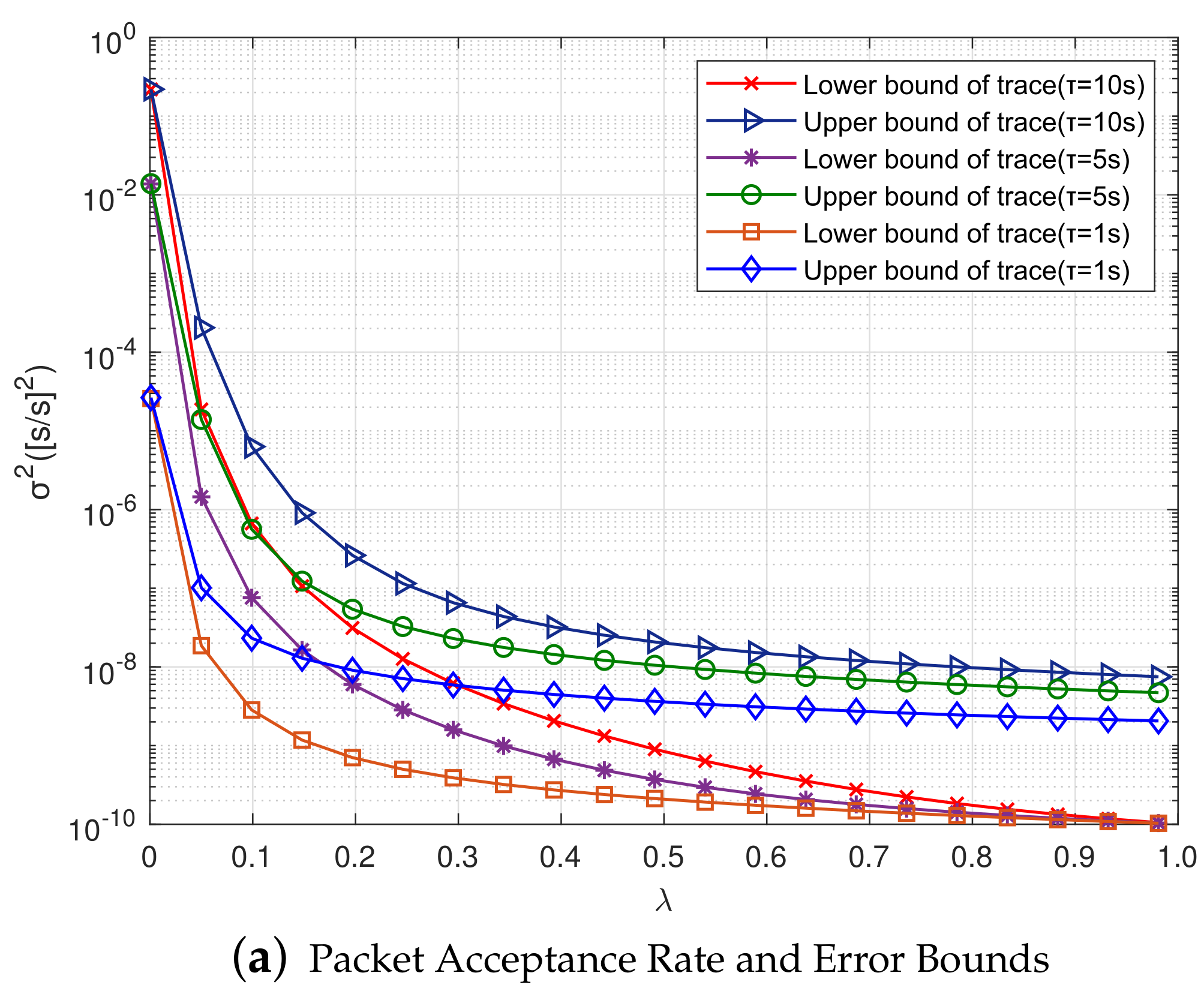
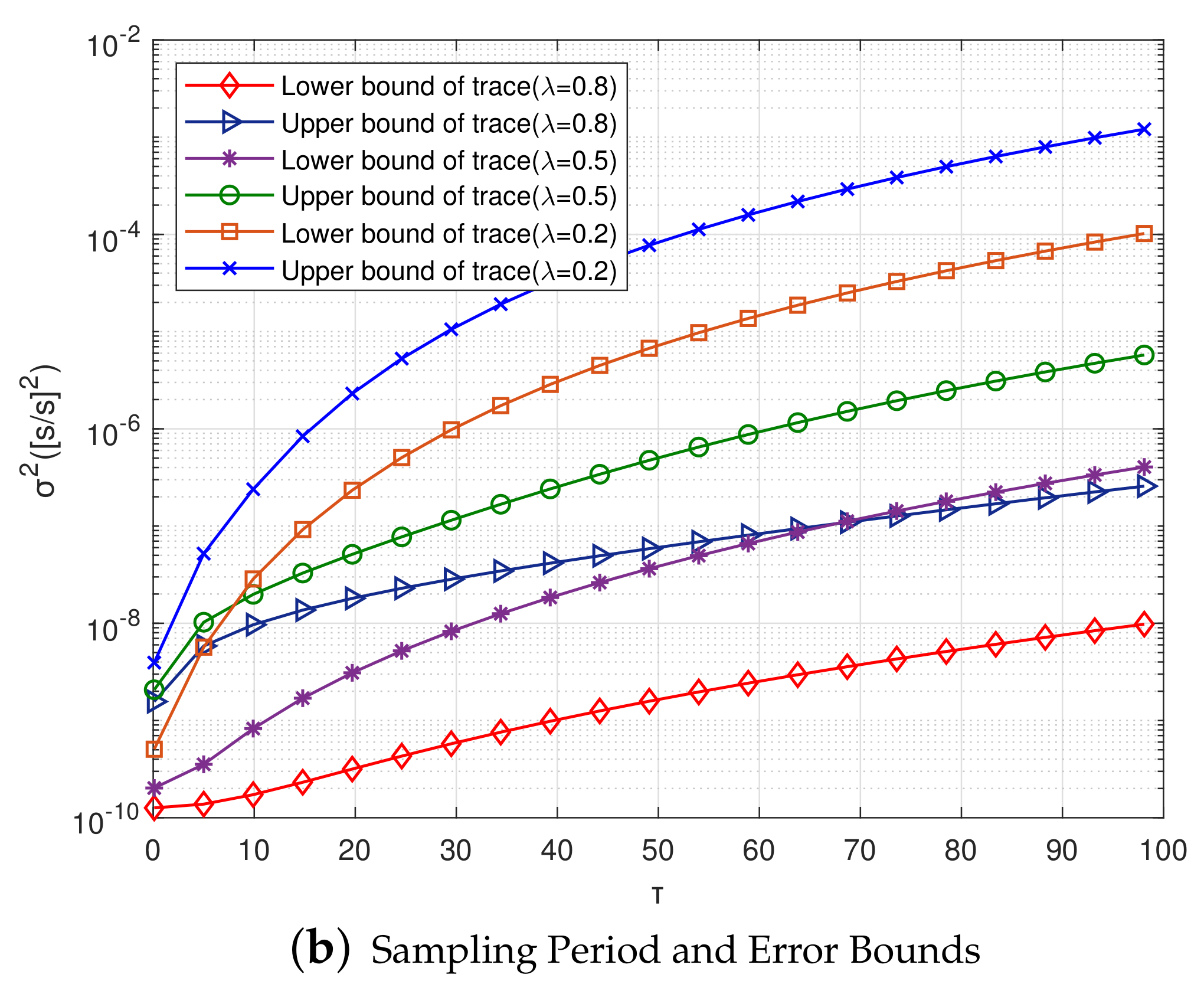
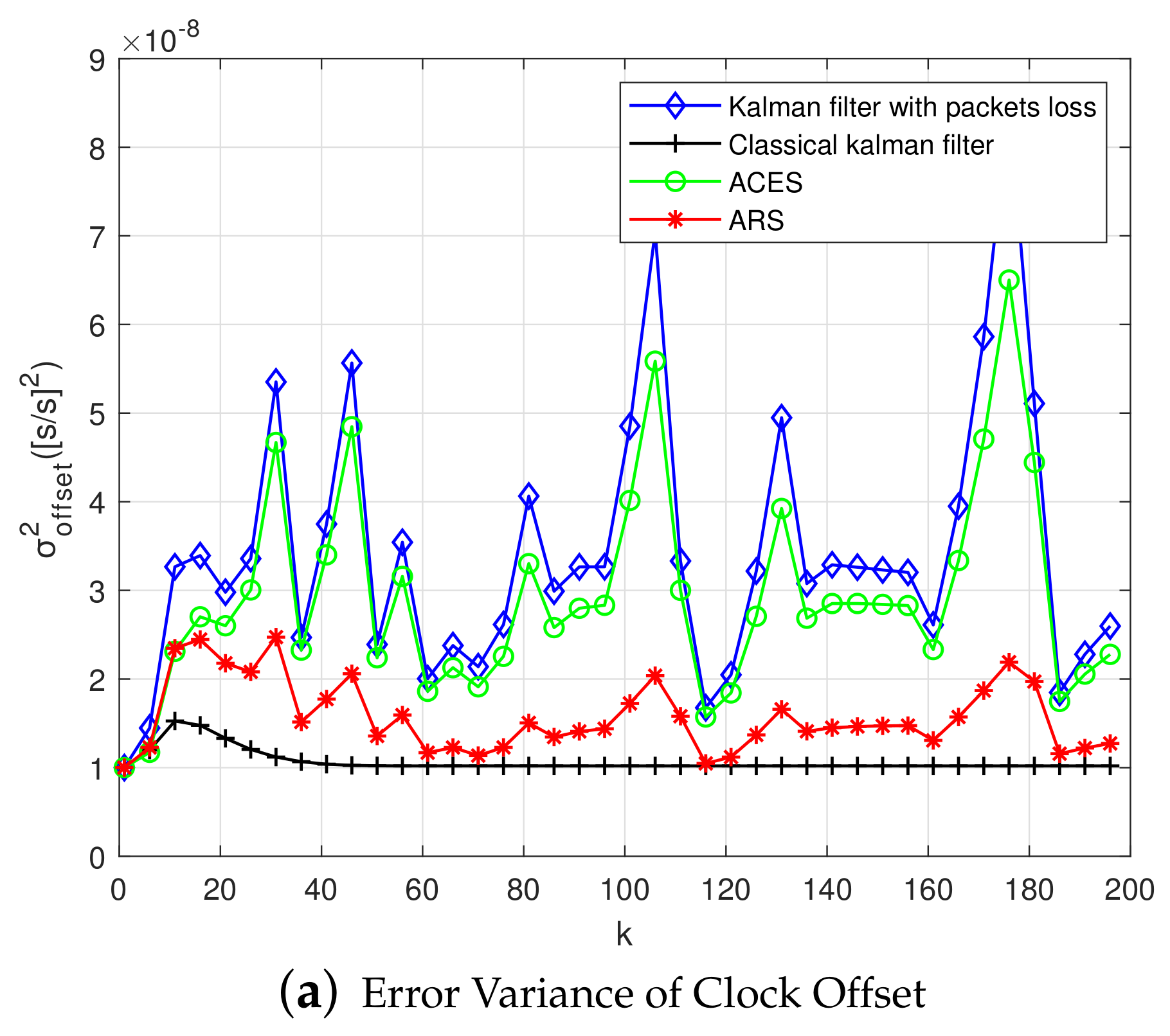
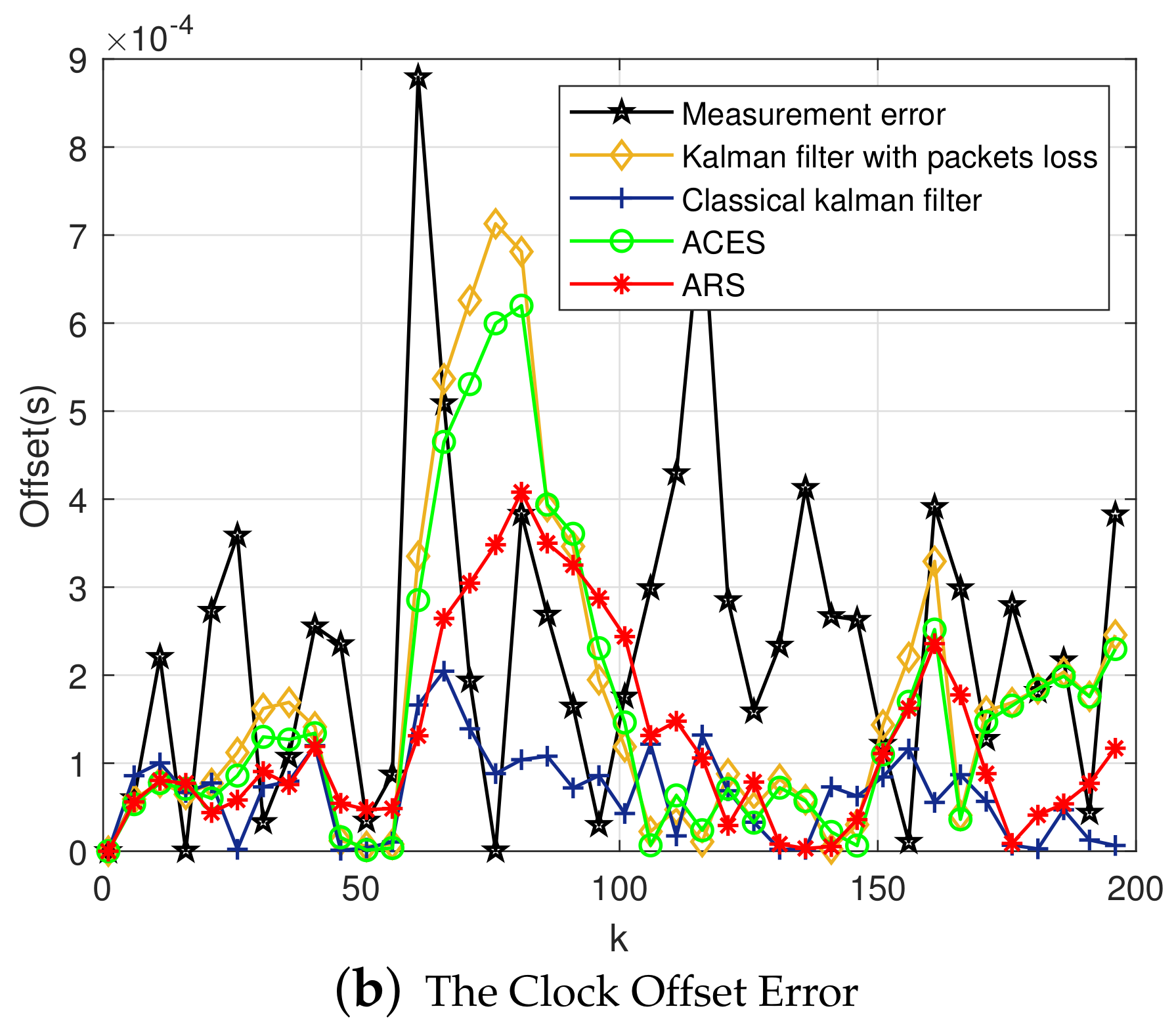
| Symbols | Description | Symbols | Description |
|---|---|---|---|
| ideal time | clock offset | ||
| clock skew | clock aging rate | ||
| offset state noise | skew state noise | ||
| aging rate state noise | state vector | ||
| A | state transition matrix | state noise | |
| observation vector | H | observation matrix | |
| Q | state noise covariance | R | observation noise covariance |
| random variable | convergent lower bound function | ||
| convergent upper bound function | offset covariance threshold | ||
| random variable | innovation | ||
| reception rate | observation noise |
| Algorithm | Case 1 | Case 2 | Case 3 | ||||||
|---|---|---|---|---|---|---|---|---|---|
| Mean | Max | Min | Mean | Max | Min | Mean | Max | Min | |
| KF with Packets Loss | 56.80 | 84.13 | 45.48 | 60.82 | 90.41 | 46.92 | 170.42 | 252.37 | 122.38 |
| Classical KF | 44.82 | 46.58 | 44.77 | 46.72 | 50.95 | 46.31 | 101.70 | 115.36 | 100.96 |
| ACES | 55.48 | 81.32 | 44.42 | 56.93 | 81.84 | 44.45 | 159.16 | 226.39 | 116.27 |
| ARS | 48.67 | 58.81 | 42.36 | 52.47 | 67.38 | 44.32 | 117.84 | 176.86 | 93.18 |
© 2020 by the authors. Licensee MDPI, Basel, Switzerland. This article is an open access article distributed under the terms and conditions of the Creative Commons Attribution (CC BY) license (http://creativecommons.org/licenses/by/4.0/).
Share and Cite
Zhang, K.; Pang, M.; Yin, Y.; Gao, S.; Chen, P. ARS: Adaptive Robust Synchronization for Underground Coal Wireless Internet of Things. Sensors 2020, 20, 4981. https://doi.org/10.3390/s20174981
Zhang K, Pang M, Yin Y, Gao S, Chen P. ARS: Adaptive Robust Synchronization for Underground Coal Wireless Internet of Things. Sensors. 2020; 20(17):4981. https://doi.org/10.3390/s20174981
Chicago/Turabian StyleZhang, Kuiyuan, Mingzhi Pang, Yuqing Yin, Shouwan Gao, and Pengpeng Chen. 2020. "ARS: Adaptive Robust Synchronization for Underground Coal Wireless Internet of Things" Sensors 20, no. 17: 4981. https://doi.org/10.3390/s20174981
APA StyleZhang, K., Pang, M., Yin, Y., Gao, S., & Chen, P. (2020). ARS: Adaptive Robust Synchronization for Underground Coal Wireless Internet of Things. Sensors, 20(17), 4981. https://doi.org/10.3390/s20174981






